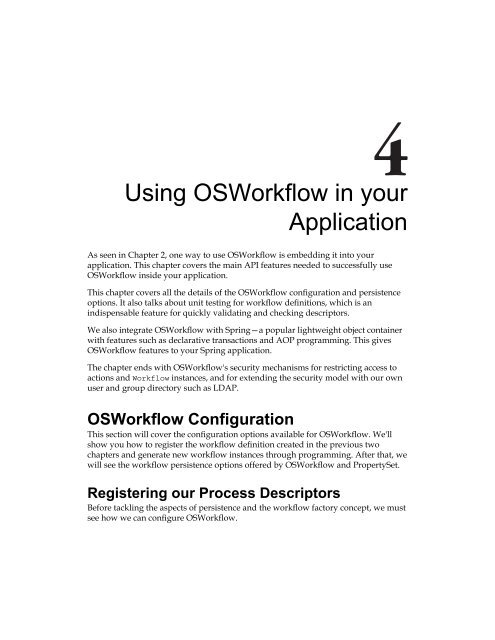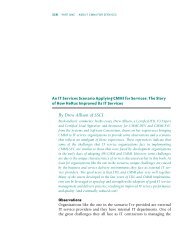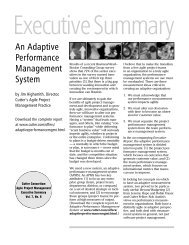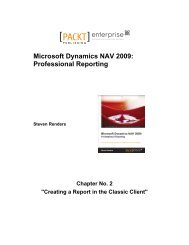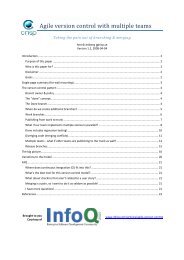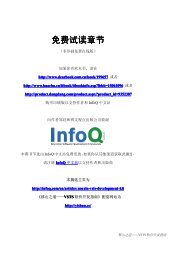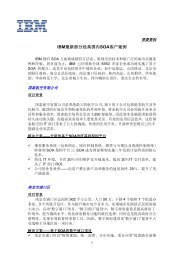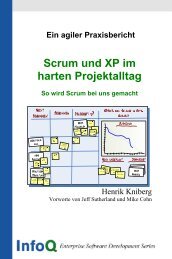Using Osworkflow in your Application
Using Osworkflow in your Application
Using Osworkflow in your Application
You also want an ePaper? Increase the reach of your titles
YUMPU automatically turns print PDFs into web optimized ePapers that Google loves.
<strong>Us<strong>in</strong>g</strong> OSWorkflow <strong>in</strong> <strong>your</strong><br />
<strong>Application</strong><br />
As seen <strong>in</strong> Chapter 2, one way to use OSWorkfl ow is embedd<strong>in</strong>g it <strong>in</strong>to <strong>your</strong><br />
application. This chapter covers the ma<strong>in</strong> API features needed to successfully use<br />
OSWorkfl ow <strong>in</strong>side <strong>your</strong> application.<br />
This chapter covers all the details of the OSWorkfl ow confi guration and persistence<br />
options. It also talks about unit test<strong>in</strong>g for workfl ow defi nitions, which is an<br />
<strong>in</strong>dispensable feature for quickly validat<strong>in</strong>g and check<strong>in</strong>g descriptors.<br />
We also <strong>in</strong>tegrate OSWorkfl ow with Spr<strong>in</strong>g—a popular lightweight object conta<strong>in</strong>er<br />
with features such as declarative transactions and AOP programm<strong>in</strong>g. This gives<br />
OSWorkfl ow features to <strong>your</strong> Spr<strong>in</strong>g application.<br />
The chapter ends with OSWorkfl ow's security mechanisms for restrict<strong>in</strong>g access to<br />
actions and Workflow <strong>in</strong>stances, and for extend<strong>in</strong>g the security model with our own<br />
user and group directory such as LDAP.<br />
OSWorkflow Configuration<br />
This section will cover the confi guration options available for OSWorkfl ow. We'll<br />
show you how to register the workfl ow defi nition created <strong>in</strong> the previous two<br />
chapters and generate new workfl ow <strong>in</strong>stances through programm<strong>in</strong>g. After that, we<br />
will see the workfl ow persistence options offered by OSWorkfl ow and PropertySet.<br />
Register<strong>in</strong>g our Process Descriptors<br />
Before tackl<strong>in</strong>g the aspects of persistence and the workfl ow factory concept, we must<br />
see how we can confi gure OSWorkfl ow.
<strong>Us<strong>in</strong>g</strong> OSWorkfl ow <strong>in</strong> <strong>your</strong> <strong>Application</strong><br />
Firstly, the framework confi gures itself by pars<strong>in</strong>g and read<strong>in</strong>g the osworkflow.xml<br />
fi le <strong>in</strong> the classpath. This fi le conta<strong>in</strong>s several sett<strong>in</strong>gs, such as the WorkflowStore<br />
implementation class name, the WorkflowFactory handler class name, and so on.<br />
The default osworkflow.xml fi le is as follows:<br />
<br />
<br />
<br />
<br />
<br />
<br />
OSWorkfl ow delegates the persistence features—such as load<strong>in</strong>g and sav<strong>in</strong>g<br />
<strong>in</strong>dividual <strong>in</strong>stances—of the eng<strong>in</strong>e to an <strong>in</strong>terface named WorkflowStore.<br />
There are several built-<strong>in</strong> implementations such as EJB, JDBC, etc. The default<br />
osworkflow.xml fi le uses the MemoryWorkflowStore implementation for persist<strong>in</strong>g<br />
<strong>in</strong>stances <strong>in</strong> memory.<br />
The WorkflowFactory is the <strong>in</strong>terface responsible for read<strong>in</strong>g workfl ow<br />
defi nitions <strong>in</strong> any format and giv<strong>in</strong>g them to the eng<strong>in</strong>e <strong>in</strong> a proper format. The<br />
default implementation is XMLWorkflowFactory; obviously this reads XML<br />
workfl ow defi nitions.<br />
As you can see, the default osworkflow.xml fi le is confi gured to use an<br />
XMLWorkflowFactory and po<strong>in</strong>ts to a resource fi le called workflows.xml. The<br />
workflows.xml fi le looks like this:<br />
<br />
<br />
<br />
<br />
The workflows.xml fi le describes which workfl ow defi nitions are available and<br />
<strong>in</strong> which fi le the eng<strong>in</strong>e can fi nd the XML data. You can see we have two different<br />
processes to <strong>in</strong>itiate—holiday and loan.<br />
[ 70 ]
[ 71 ]<br />
Chapter 4<br />
Embedd<strong>in</strong>g OSWorkflow <strong>in</strong>to <strong>your</strong><br />
<strong>Application</strong><br />
OSWorkfl ow can be embedded <strong>in</strong> any application whether it's J2SE or JEE based by<br />
simply <strong>in</strong>clud<strong>in</strong>g the osworkflow.jar fi le <strong>in</strong>to the classpath of the application. In<br />
any case, you must have the osworkflow.xml fi le, any referenced resources such<br />
as workflows.xml, and the XML of the process <strong>in</strong> the classpath. In this case, the<br />
workfl ow descriptor name is holiday.xml.<br />
Start<strong>in</strong>g a Workflow<br />
Imag<strong>in</strong>e you have an application that <strong>in</strong>terfaces with OSWorkfl ow, and you'd like to<br />
<strong>in</strong>stantiate a new Workflow. This is as easy as:<br />
Workflow wf = new BasicWorkflow("johndoe");<br />
Long id = Wf.<strong>in</strong>itialize("holiday", 1, null);<br />
The fi rst l<strong>in</strong>e creates a new BasicWorkflow with the current username as parameter.<br />
BasicWorkflow objects are heavyweight and it is reasonable to have one <strong>in</strong>stance per<br />
user to avoid the creation cost.<br />
The second l<strong>in</strong>e executes the <strong>in</strong>itialize() method with the workfl ow name as the<br />
fi rst parameter, the <strong>in</strong>itial action number as the second parameter, and the actions<br />
<strong>in</strong>put map as the third parameter. In this case, the workfl ow name is the defi nition<br />
name as stated <strong>in</strong> the workflows.xml fi le. We send null as the third parameter<br />
because we need no <strong>in</strong>put parameters to <strong>in</strong>stantiate this particular workfl ow.<br />
The returned Long is the workfl ow identifi cation number assigned by the eng<strong>in</strong>e.<br />
The <strong>in</strong>itial number is defi ned <strong>in</strong> the WorkflowDescriptor. If this ID is <strong>in</strong>correct, the<br />
eng<strong>in</strong>e will throw an InvalidActionException.<br />
This code snippet doesn't call the Configuration object. This is very<br />
important if you plan to use differently confi gured Workfl ows <strong>in</strong> the<br />
same JVM.<br />
Before <strong>in</strong>itializ<strong>in</strong>g a workfl ow <strong>in</strong>stance, you can test it by call<strong>in</strong>g the Workflow<br />
<strong>in</strong>terface method, canInitialize(). If this method returns true, then you can safely<br />
execute the <strong>in</strong>itialize() method.<br />
boolean canInit = wf.canInitialize("Holiday", 1, null)
<strong>Us<strong>in</strong>g</strong> OSWorkfl ow <strong>in</strong> <strong>your</strong> <strong>Application</strong><br />
Execut<strong>in</strong>g Actions<br />
We now have a newly created <strong>in</strong>stance; let's execute some actions. We need to <strong>in</strong>voke<br />
the doAction method of the Workflow <strong>in</strong>terface. The code is as follows:<br />
Wf.doAction(id, 1, null);<br />
The parameters are the workfl ow identifi er number, the action number ID (now you<br />
can see why actions must be uniquely numbered with<strong>in</strong> a defi nition), and a map<br />
with <strong>in</strong>puts for the workfl ow. We send null as the third parameter <strong>in</strong>dicat<strong>in</strong>g that<br />
there is no need of external <strong>in</strong>puts for this workfl ow type and action.<br />
Every call to the <strong>in</strong>itialize() and doAction() methods takes a map as an <strong>in</strong>put<br />
parameter. The transient variables map is merged with this <strong>in</strong>put map, so you can<br />
also fi nd the <strong>in</strong>put content. This is the ma<strong>in</strong> mechanism to send <strong>in</strong>formation to the<br />
Workflow <strong>in</strong>stance from the caller. The <strong>in</strong>put map key name is preserved <strong>in</strong> the<br />
transient variables map.<br />
What's the Status?<br />
To get the current steps of the workfl ow, you must call the getCurrentSteps()<br />
method of the Workflow <strong>in</strong>terface. The code snippet is as follows:<br />
List steps = wf.getCurrentSteps(id);<br />
This method returns a list of StepDescriptor, one for each current step<br />
of the Workflow <strong>in</strong>stance. To see the step <strong>in</strong>formation, we must call the<br />
WorkflowDescriptor. The follow<strong>in</strong>g code snippet shows you how to do that:<br />
for (Iterator iterator = steps.iterator(); iterator.hasNext();)<br />
{<br />
Step step = (Step) iterator.next();<br />
StepDescriptor sd = wd.getStep(step.getStepId());<br />
}<br />
By iterat<strong>in</strong>g the current step list and look<strong>in</strong>g up a StepDescriptor from the<br />
WorkflowDescriptor, we can get detailed step <strong>in</strong>formation, such as the ID, start<br />
date, fi nish date, and name of the step. If you want to see the history steps, call the<br />
getHistorySteps() method. The code is as follows:<br />
List steps = wf.getHistorySteps(id);<br />
Similarly to its current steps counterpart, getHistorySteps returns a list of<br />
StepDescriptor, this time with the completed steps of the Workflow <strong>in</strong>stance. To<br />
describe the history steps, you can use the code snippet mentioned earlier to describe<br />
the current steps.<br />
[ 72 ]
[ 73 ]<br />
Chapter 4<br />
What can I Do?<br />
Typically <strong>in</strong> user <strong>in</strong>terfaces, you must see the actions available for the current<br />
steps and the current user. The Workflow <strong>in</strong>terface has a method called<br />
getAvailableActions() for that purpose. The follow<strong>in</strong>g code fragment shows how<br />
to <strong>in</strong>voke it:<br />
<strong>in</strong>t[] actions = wf.getAvailableActions(id, null);<br />
The parameters are the workfl ow <strong>in</strong>stance identifi er and the parameters map aga<strong>in</strong>.<br />
For some action to show as available, it must satisfy some condition such as the<br />
existence of external data. The pass<strong>in</strong>g of the map allows for this sort of scenario to<br />
happen. The method returns an array of action IDs. To retrieve the action names, you<br />
must use the WorkflowDescriptor. See the follow<strong>in</strong>g snippet:<br />
WorkflowDescriptor wd =<br />
wf.getWorkflowDescriptor(wf.getWorkflowName(id));<br />
for (<strong>in</strong>t i = 0; i < actions.length; i++)<br />
{<br />
Str<strong>in</strong>g name = wd.getAction(actions[i]).getName();<br />
}<br />
The code iterates over the action ID array and calls the getAction() descriptor<br />
method. This method returns an ActionDescriptor—an object that describes an<br />
action <strong>in</strong> the defi nition. F<strong>in</strong>ally, it calls the ActionDescriptor.getName() method to<br />
obta<strong>in</strong> the name of the action.<br />
The Useful Abstract States<br />
Besides the current status and old status values you provide <strong>in</strong> the defi nition,<br />
OSWorkfl ow has the concept of an abstract state, which is a state every workfl ow has<br />
implicitly. These states are as follows:<br />
State Description<br />
Activated Workfl ow is live.<br />
Completed Workfl ow has been fi nished without any problem.<br />
Created Workfl ow has been <strong>in</strong>itialized but no actions have been executed yet.<br />
Killed Workfl ow has been canceled.<br />
Suspended Workfl ow has been suspended.<br />
Unknown The state of the workfl ow is unknown.<br />
Programmatically you can know the abstract state for a particular Workflow <strong>in</strong>stance<br />
by call<strong>in</strong>g the getEntryState() method.<br />
<strong>in</strong>t abstract = wf.getEntryState(long id)
<strong>Us<strong>in</strong>g</strong> OSWorkfl ow <strong>in</strong> <strong>your</strong> <strong>Application</strong><br />
You can change the abstract state of the <strong>in</strong>stance by call<strong>in</strong>g the changeEntryState()<br />
method of the Workflow <strong>in</strong>terface. Be sure to check the abstract state constants<br />
present <strong>in</strong> the Workflow <strong>in</strong>terface.<br />
Query<strong>in</strong>g the Workflow Store<br />
Human-oriented BPMS have GUIs that let the user realize tasks and search<br />
for work items. OSWorkfl ow permits search<strong>in</strong>g the workfl ow store via a<br />
WorkflowExpressionQuery. This class is a GOF composite design pattern, so you<br />
can nest expressions <strong>in</strong>to expressions for complex queries.<br />
This search is a very generic one <strong>in</strong>clud<strong>in</strong>g only the fi elds <strong>in</strong> OSWorkfl ow.<br />
For more powerful searches, you should create a doma<strong>in</strong> concept that can<br />
be attached to the workfl ow ID. For example, the holiday workfl ow uses<br />
the doma<strong>in</strong> concept of an Employee Request.<br />
You should have an Employee Request table with all the important<br />
doma<strong>in</strong> data, such as department, dates, etc. This is the table to be<br />
searched when doma<strong>in</strong> data is needed. If you can survive with only the<br />
workfl ow default data, the follow<strong>in</strong>g search is very useful.<br />
The follow<strong>in</strong>g code example searches the store for Workflows hav<strong>in</strong>g current steps<br />
with the OWNER equal to johndoe. Don't worry about the owner; we'll see this concept<br />
<strong>in</strong> the security section of this chapter.<br />
WorkflowExpressionQuery q = new WorkflowExpressionQuery<br />
(new FieldExpression(FieldExpression.OWNER,<br />
FieldExpression.CURRENT_STEPS,<br />
FieldExpression.EQUALS, "johndoe"));<br />
List wfs = wf.query(q);<br />
The follow<strong>in</strong>g fi elds are available for search<strong>in</strong>g:<br />
Field Description<br />
ACTION The action that triggered the transition to the step.<br />
CALLER The caller of the action.<br />
DUE_DATE The due date of the step.<br />
FINISH_DATE The fi nish date of the step. It is Null if the step is not yet fi nished.<br />
OWNER The owner of the step.<br />
START_DATE The start date of the step.<br />
STATE The state of the workfl ow.<br />
STATUS The status of the step.<br />
STEP The step.<br />
NAME The name of the bus<strong>in</strong>ess process.<br />
[ 74 ]
The contexts are as follows:<br />
Context Description<br />
CURRENT_STEPS The current steps of the workfl ow<br />
ENTRY The workfl ow entry that is the header <strong>in</strong>formation<br />
HISTORY_STEPS The history steps of the workfl ow<br />
The operators are as follows:<br />
Operator Description<br />
EQUALS Equals operator<br />
GT Greater than operator<br />
LT Less than operator<br />
NOT_EQUALS Not Equals operator<br />
[ 75 ]<br />
Chapter 4<br />
The workfl ow store dra<strong>in</strong>s performance from transactional activity, so use it with<br />
care. Some workfl ow stores don't support query<strong>in</strong>g while others don't support<br />
nested expressions; so be sure to check <strong>your</strong> store. For example, the HibernateStore<br />
<strong>in</strong>cluded <strong>in</strong> OSWorkfl ow currently doesn't support nested expressions.<br />
Query<strong>in</strong>g the Workflow Factory<br />
The WorkflowFactory <strong>in</strong>terface has the follow<strong>in</strong>g methods to <strong>in</strong>spect the available<br />
workfl ows descriptors.<br />
The getWorkflowName() method returns the workfl ow name of a particular<br />
Workflow <strong>in</strong>stance. The getWorkflowNames() method returns an array of str<strong>in</strong>gs<br />
with all the available workfl ow defi nition names. Check the follow<strong>in</strong>g snippet for the<br />
usage of these methods:<br />
Str<strong>in</strong>g wfName = workflow.getWorkflowName(workflowId);<br />
System.out.pr<strong>in</strong>tln("available workflows:" +<br />
Arrays.toStr<strong>in</strong>g(workflow.getWorkflowNames()));<br />
This code is needed when there's more than one WorkflowDescriptor <strong>in</strong> <strong>your</strong><br />
system and you want to programmatically query their names. Once you have their<br />
names, you can <strong>in</strong>stantiate new workfl ows or <strong>in</strong>spect their descriptors.
<strong>Us<strong>in</strong>g</strong> OSWorkfl ow <strong>in</strong> <strong>your</strong> <strong>Application</strong><br />
Inspect<strong>in</strong>g the Workflow Descriptor from<br />
Code<br />
The XMLWorkflowDescriptor describes a bus<strong>in</strong>ess process <strong>in</strong> a human-readable<br />
format. When OSWorkfl ow parses and validates the XML, it builds a memory<br />
structure called the WorkflowDescriptor. This descriptor has all the <strong>in</strong>formation<br />
that the process eng<strong>in</strong>e needs to follow the process and to create a new <strong>in</strong>stance of<br />
the Workflow. We can get a hold of the descriptor of any factory-registered Workflow<br />
by call<strong>in</strong>g the getWorkflowDescriptor() method of the Workflow <strong>in</strong>terface. The<br />
follow<strong>in</strong>g code fragment shows a sample <strong>in</strong>vocation:<br />
WorkflowDescriptor wd = wf.getWorkflowDescriptor("holiday");<br />
This code will return an object representation of the XML workfl ow descriptor that<br />
we built <strong>in</strong> Chapter 2. By travers<strong>in</strong>g the descriptor, we can analyze the process<br />
structure and get the steps, actions, results, etc. of the WorkflowDescriptor.<br />
Don't confuse the WorkflowDescriptor with its <strong>in</strong>stances.<br />
You can also build a WorkflowDescriptor programmatically; it is useful for<br />
dynamic on-the-fl y processes.<br />
<strong>Us<strong>in</strong>g</strong> the Workflow Configuration Object<br />
The examples of <strong>in</strong>stantiat<strong>in</strong>g a new workfl ow that have been discussed so far didn't<br />
make any reference to the Configuration object. If you don't call the Configuration<br />
object, OSWorkfl ow assumes a unique confi guration for workfl ows <strong>in</strong> the JVM. If<br />
you plan to use workfl ows with different store and factory options, you must call the<br />
Configuration object. The follow<strong>in</strong>g code fragment shows you how:<br />
Workflow workflow = new BasicWorkflow("Holiday");<br />
Configuration config = new DefaultConfiguration();<br />
workflow.setConfiguration(config);<br />
It is recommended to call the Configuration object for fl exibility. Be sure to call<br />
the setConfiguration method of the Workflow <strong>in</strong>terface to use the per-<strong>in</strong>stance<br />
confi guration model.<br />
[ 76 ]
[ 77 ]<br />
Chapter 4<br />
Workflow Interface Implementations<br />
OSWorkfl ow offers great extensibility by giv<strong>in</strong>g us different implementations of the<br />
Workflow <strong>in</strong>terface. The follow<strong>in</strong>g table summarizes the relevant features of each one:<br />
Implementation Features<br />
BasicWorkflow Basic implementation. It doesn't support transactions.<br />
OfBiz Based on OfBiz, it supports local transactions.<br />
EJBWorkflow <strong>Us<strong>in</strong>g</strong> JTA and CMP, it supports global XA transactions. It must be<br />
used only <strong>in</strong>side J2EE-compliant application servers, like JBoss.<br />
The OfBiz implementation is based on the transaction components of the OfBiz suite<br />
(an open-source ERP) to implement local transactions i.e., JDBC transactions. Use it<br />
only if you are stor<strong>in</strong>g the Workflow <strong>in</strong>stance data <strong>in</strong> a JDBC-compliant database.<br />
On the other hand, the EJBWorkflow alternative will use the JTA J2EE API to create<br />
a global transaction <strong>in</strong> each method <strong>in</strong>vocation, caus<strong>in</strong>g an unnecessary overhead for<br />
simple applications. Use it only if you need distributed transactions, i.e. a workfl ow<br />
action and another database <strong>in</strong>serted <strong>in</strong> one transaction.<br />
Implementations support<strong>in</strong>g transactions like OfBiz and EJBWorkflow can roll back<br />
the current transaction by call<strong>in</strong>g the setRollbackOnly() method. Also, <strong>in</strong> the<br />
case of an exception, OSWorkfl ow will roll back the current transaction to preserve<br />
data consistency.<br />
To change <strong>your</strong> current implementation just <strong>in</strong>stantiate the implementation class<br />
<strong>in</strong>stead of BasicWorkflow.<br />
Remember that BasicWorkflow doesn't support transactions!<br />
If none of the options suits <strong>your</strong> needs, you can create <strong>your</strong> own Workflow class by<br />
implement<strong>in</strong>g the Workflow <strong>in</strong>terface.<br />
Load<strong>in</strong>g the Descriptors—the Workflow<br />
Factory<br />
As we have seen before, OSWorkfl ow delegates the responsibility of load<strong>in</strong>g<br />
workfl ow defi nitions to a WorkflowFactory implementation. There are three<br />
built-<strong>in</strong> implementations to choose from, namely, XMLWorkflowFactory,<br />
JDBCWorkflowFactory, and Spr<strong>in</strong>gHibernateWorkflowFactory.
<strong>Us<strong>in</strong>g</strong> OSWorkfl ow <strong>in</strong> <strong>your</strong> <strong>Application</strong><br />
Don't confuse the WorkflowFactory with the WorkflowStore. The<br />
fi rst one manages the descriptors while the latter manages the workfl ow<br />
<strong>in</strong>stance data.<br />
XMLWorkflowFactory loads the process defi nition from an XML fi le <strong>in</strong> the fi le<br />
system. This is the default implementation. It takes only one parameter called<br />
resource, which specifi es the workflow XML fi le name. This fi le is loaded from the<br />
classpath. A slightly modifi ed variation is the Spr<strong>in</strong>gWorkflowFactory, which looks<br />
up the XML fi les from a Spr<strong>in</strong>g resource.<br />
Load<strong>in</strong>g Descriptors from a Database<br />
JDBCWorkflowFactory uses the database to load the workfl ow descriptors. This<br />
is done with a BLOB or LONG VARCHAR column. To use this factory, you must declare<br />
it <strong>in</strong> osworkflow.xml fi le; it takes a mandatory parameter called datasource,<br />
which an is the JNDI name of the JDBC datasource to be used. See the follow<strong>in</strong>g<br />
osworkflow.xml fi le:<br />
<br />
<br />
<br />
<br />
<br />
This sample fi le will try to look up a JNDI resource called jdbc/Defaultds and<br />
then try to get a connection from it. F<strong>in</strong>ally, it will try to use a database table named<br />
OS_WORKFLOWDEFS to fi nd the workfl ow descriptors. This table is composed of<br />
two columns, the fi rst WF_NAME, which is the workfl ow name and is of the CHAR or<br />
VARCHAR type while the second column is WF_DEFINITION. The whole XML will be<br />
stored <strong>in</strong> this column as a BINARY or TEXT type.<br />
Spr<strong>in</strong>gHibernateWorkflowFactory is the same as above, but uses the Hibernate<br />
framework, benefi t<strong>in</strong>g from cach<strong>in</strong>g and the high-performance ORM features.<br />
Each WorkflowFactory retrieves a WorkflowDescriptor, a class represent<strong>in</strong>g<br />
the structure of the defi nition <strong>in</strong> an object-oriented way. Implement<strong>in</strong>g <strong>your</strong> own<br />
WorkflowFactory enables you to build workfl ow defi nitions on the fl y. You can<br />
implement a template defi nition and customize it on the fl y us<strong>in</strong>g some rules.<br />
You can build <strong>your</strong> own implementation if none of the options fi ts <strong>your</strong> requirement<br />
by implement<strong>in</strong>g the WorkflowFactory <strong>in</strong>terface.<br />
[ 78 ]
[ 79 ]<br />
Chapter 4<br />
Persist<strong>in</strong>g Instance Information<br />
OSWorkfl ow delegates the responsibility of load<strong>in</strong>g and stor<strong>in</strong>g <strong>in</strong>stance data to the<br />
WorkflowStore. Later <strong>in</strong> the section we'll see the different built-<strong>in</strong> alternatives. First,<br />
we'll take a look at exactly which data is made persistent.<br />
The data that is made persistent <strong>in</strong> OSWorkfl ow when you use one of the<br />
database-backed alternatives is as follows:<br />
•<br />
•<br />
•<br />
Workfl ow entry: The <strong>in</strong>stance header data, such as process name, abstract<br />
state, etc.<br />
Current and history steps: The steps that were travelled and the one that the<br />
workfl ow is <strong>in</strong>.<br />
PropertySet: The persistent <strong>in</strong>stance-specifi c data.<br />
The follow<strong>in</strong>g fi gure displays the relationships between them.<br />
HistorySteps CurrentSteps<br />
0..* 0..*<br />
WorkflowEntry<br />
0..1<br />
PropertySet<br />
OSWorkfl ow gives several choices for stor<strong>in</strong>g this <strong>in</strong>formation. It's very important<br />
that you chose <strong>your</strong> strategy carefully for ma<strong>in</strong>tenance and performance reasons.<br />
You can confi gure the persistence strategy <strong>in</strong> the osworkflow.xml fi le.<br />
Persistence Choices<br />
T he follow<strong>in</strong>g are the built-<strong>in</strong> WorkflowStore implementations <strong>in</strong> OSWorkfl ow:<br />
Memory Store<br />
This store strategy saves the workfl ow <strong>in</strong>formation <strong>in</strong> RAM, useful for test<strong>in</strong>g <strong>your</strong><br />
bus<strong>in</strong>ess processes.
<strong>Us<strong>in</strong>g</strong> OSWorkfl ow <strong>in</strong> <strong>your</strong> <strong>Application</strong><br />
JDBC<br />
This uses pla<strong>in</strong> old JDBC to access and save the data. It lacks the cach<strong>in</strong>g and fetch<strong>in</strong>g<br />
strategies of Hibernate. The JDBC store is a more basic strategy than Hibernate and is<br />
suitable only for very simple workfl ow applications.<br />
Hibernate<br />
The Hibernate store uses this ORM framework to manage the persistence of<br />
Workflows. It has the advantage of high performance ORM features such as cach<strong>in</strong>g.<br />
Hibernate uses XML fi les to map objects to relational concepts. In the mapp<strong>in</strong>g fi les,<br />
you can tune parameters such as fetch<strong>in</strong>g strategies and lazy load<strong>in</strong>g. For more<br />
<strong>in</strong>formation about Hibernate, take a look at www.hibernate.org.<br />
This store is highly recommended as the default production store of OSWorkfl ow.<br />
Other Stores<br />
OSWorkfl ow is bundled with other store implementations like<br />
MySQLWorkflowStore, SerializableStore, OfBizStore, and EJBStore. Be aware<br />
that they are designed for very specifi c scenarios.<br />
If none of the previous strategies suits <strong>your</strong> needs, then you can build one by<br />
implement<strong>in</strong>g the WorkflowStore <strong>in</strong>terface.<br />
Configur<strong>in</strong>g the JDBC Store<br />
I n this section, we'll confi gure the JDBC Store for basic usage. This store expects<br />
several confi guration parameters <strong>in</strong> the osworkflow.xml fi le:<br />
<br />
<br />
<br />
<br />
<br />
<br />
<br />
<br />
<br />
<br />
<br />
<br />
<br />
<br />
<br />
[ 80 ]
<br />
<br />
<br />
<br />
<br />
<br />
<br />
<br />
<br />
The most important confi guration sett<strong>in</strong>g is the JNDI datasource, <strong>in</strong> this case<br />
jdbc/Defaultds. You must use the same name that you've used to confi gure the<br />
application server's datasource.<br />
[ 81 ]<br />
Chapter 4<br />
The other parameters map the tables, column names, and sequences to be used with<br />
the JDBC-backed store. If you didn't modify the <strong>in</strong>cluded SQL scripts, then these<br />
values will work right out of the box. Then you should take a look at the entry and<br />
step sequences, which vary a lot across database vendors.<br />
Search for SQL scripts tailored to different databases <strong>in</strong> the src\etc\<br />
deployment\jdbc directory.<br />
After you have executed the SQL script and confi gured the osworkflow.xml fi le, all<br />
the new Workflow <strong>in</strong>stance and associated data will be stored <strong>in</strong> the database.<br />
PropertySet Persistence<br />
If you're go<strong>in</strong>g to use the PropertySet functionality with<strong>in</strong> <strong>your</strong><br />
WorkflowDescriptor and you want to persist the variables, then you must confi gure<br />
the PropertySet to use the database <strong>in</strong>stead of the system's memory.<br />
You can confi gure the PropertySet persistence mechanism <strong>in</strong> the propertyset.xml<br />
fi le <strong>in</strong> the classpath. If you are us<strong>in</strong>g a JDBC-based store for persist<strong>in</strong>g <strong>in</strong>stance data,<br />
then you should use the PropertySet's counterpart, the JDBCPropertySet. As you<br />
might have guessed, it stores the PropertySet data <strong>in</strong> a couple of database tables.<br />
Configur<strong>in</strong>g the JDBC PropertySet<br />
H ere is the confi guration (propertyset.xml) to use a JDBC-based PropertySet:<br />
<br />
<br />
<strong>Us<strong>in</strong>g</strong> OSWorkfl ow <strong>in</strong> <strong>your</strong> <strong>Application</strong><br />
<br />
<br />
<br />
<br />
<br />
<br />
<br />
<br />
<br />
<br />
<br />
This snippet is self-descriptive and <strong>in</strong>cludes the usual JNDI datasource name, the<br />
table, and each of the column names.<br />
Unit Test<strong>in</strong>g <strong>your</strong> Workflow<br />
A fter construct<strong>in</strong>g and chang<strong>in</strong>g <strong>your</strong> bus<strong>in</strong>ess processes, you will want to validate<br />
the functionality and fl ow. This section expla<strong>in</strong>s how to use the JUnit framework to<br />
verify the correctness and completeness of <strong>your</strong> bus<strong>in</strong>ess process. This verifi cation is<br />
called unit test<strong>in</strong>g.<br />
What is JUnit?<br />
J Unit is a unit-test<strong>in</strong>g framework for Java. JUnit is based on a TestCase concept: each<br />
TestCase conta<strong>in</strong>s a set of assertions; if any of these assertions fail, the TestCase<br />
fails. To run unit tests you need to download JUnit from http://junit.org/<br />
<strong>in</strong>dex.html. Unpack the distribution and copy junit.jar to <strong>your</strong> classpath; that's<br />
the only fi le we need to run our example (<strong>in</strong> addition to the OSWorkfl ow libraries<br />
we've used before).<br />
For this example, we'll build a JUnit TestCase with a set of assertions about the<br />
current steps and available actions of a sample WorkflowDescriptor. You can<br />
extend this example with <strong>your</strong> own set of assertions, as they vary across bus<strong>in</strong>ess<br />
processes. Here's the TestCase code:<br />
package packtpub.osw;<br />
import java.util.Collection;<br />
import java.util.HashMap;<br />
import junit.framework.TestCase;<br />
import com.opensymphony.workflow.Workflow;<br />
import com.opensymphony.workflow.basic.BasicWorkflow;<br />
import com.opensymphony.workflow.config.Configuration;<br />
import com.opensymphony.workflow.config.DefaultConfiguration;<br />
import com.opensymphony.workflow.spi.Step;<br />
[ 82 ]
[ 83 ]<br />
Chapter 4<br />
/**<br />
* Basic workflow testcase<br />
*/<br />
public class WorkflowTestCase extends TestCase<br />
{<br />
private Workflow workflow;<br />
private long workflowId;<br />
/** Creates a workflow <strong>in</strong>stance for test<strong>in</strong>g. **/<br />
public void setUp()<br />
{<br />
f<strong>in</strong>al Str<strong>in</strong>g wfName = "holiday2";<br />
workflow = new BasicWorkflow("test");<br />
Configuration config = new DefaultConfiguration();<br />
workflow.setConfiguration(config);<br />
try<br />
{<br />
workflowId = workflow.<strong>in</strong>itialize(wfName, 100, new HashMap());<br />
} catch (Exception e)<br />
{<br />
e.pr<strong>in</strong>tStackTrace();<br />
}<br />
}<br />
}<br />
public void testWorkflow()<br />
{<br />
try<br />
{<br />
<strong>in</strong>t[] availableActions =<br />
workflow.getAvailableActions(workflowId,null);<br />
assertEquals("Unexpected number of available actions", 1,<br />
availableActions.length);<br />
assertEquals("Unexpected available action", 1,<br />
availableActions[0]);<br />
Collection currentSteps =<br />
workflow.getCurrentSteps(workflowId);<br />
assertEquals("Unexpected number of current steps", 1,<br />
currentSteps.size());<br />
Step currentStep = (Step) currentSteps.iterator().next();<br />
assertEquals("Unexpected current step", 1,<br />
currentStep.getStepId());<br />
} catch (Exception e)<br />
{<br />
e.pr<strong>in</strong>tStackTrace();<br />
fail();<br />
}<br />
}
<strong>Us<strong>in</strong>g</strong> OSWorkfl ow <strong>in</strong> <strong>your</strong> <strong>Application</strong><br />
T he setup() method is the fi rst th<strong>in</strong>g to be executed by JUnit by convention. Our test<br />
extends from TestCase as every JUnit test does, and the testWorkflow()method<br />
is the one executed by the framework after the setup() method. All methods<br />
that start with the name "test" will be executed as part of the TestCase. In the<br />
testWorkflow() method, you'll notice several assertEquals <strong>in</strong>vocations; these are<br />
the JUnit assertions. For example, take the follow<strong>in</strong>g block of code:<br />
<strong>in</strong>t[] availableActions =<br />
workflow.getAvailableActions(workflowId,null);<br />
assertEquals("Unexpected number of available actions", 1,<br />
availableActions.length);<br />
assertEquals("Unexpected available action", 1,<br />
availableActions[0]);<br />
First, we will query the available actions of the Workflow <strong>in</strong>stance, which we created <strong>in</strong><br />
the setUp() method. Then, we will test the assertion of the number of available actions<br />
(<strong>in</strong> this case, it's just one) and the identifi er of the available action (<strong>in</strong> this case, 1).<br />
The second block checks that the new <strong>in</strong>stance is <strong>in</strong> exactly one current step and this<br />
step has the identifi er 1:<br />
Collection currentSteps =<br />
workflow.getCurrentSteps(workflowId);<br />
assertEquals("Unexpected number of current steps", 1,<br />
currentSteps.size());<br />
Step currentStep = (Step) currentSteps.iterator().next();<br />
assertEquals("Unexpected current step", 1,<br />
currentStep.getStepId());<br />
F<strong>in</strong>ally <strong>in</strong> the catch block, there's one fail() method to cancel the test if anyth<strong>in</strong>g<br />
goes wrong.<br />
} catch (Exception e)<br />
{<br />
e.pr<strong>in</strong>tStackTrace();<br />
fail();<br />
}<br />
When we are done with cod<strong>in</strong>g the unit test, it's time to run it, and verify the<br />
assertion, thus validat<strong>in</strong>g the user requirements about the bus<strong>in</strong>ess process.<br />
[ 84 ]
Runn<strong>in</strong>g the Tests<br />
T he JUnit test<strong>in</strong>g framework is made up of only one JAR fi le, junit.jar. To run<br />
the TestCase, you must have this JAR <strong>in</strong> <strong>your</strong> classpath and must execute the<br />
follow<strong>in</strong>g command:<br />
[ 85 ]<br />
Chapter 4<br />
C:\org.junit_3.8.1>java -cp junit.jar;osworkflow-2.8.0.jar;<br />
commons-logg<strong>in</strong>g.jar;<br />
propertyset-1.4.jar<br />
junit.textui.TestRunner.packtpub.osw.WorkflowTestCase;<br />
This command will <strong>in</strong>voke the JUnit default TestRunner on our packtpub.osw.<br />
WorkflowTestCase. TestRunner is a class responsible for execut<strong>in</strong>g each TestCase<br />
and return<strong>in</strong>g the success or failure code of each one. JUnit has several TestRunners,<br />
some text-based and others graphical. Refer to the JUnit documentation for<br />
more details.<br />
The output of the previous command is as follows:<br />
C:\org.junit_3.8.1>java -cp junit.jar;osworkflow-2.8.0.jar;<br />
commons-logg<strong>in</strong>g.jar;<br />
propertyset-1.4.jar<br />
junit.textui.TestRunner.packtpub.osw.WorkflowTestCase;<br />
Time: 0,25<br />
OK (1 test)<br />
C: \org.junit_3.8.1><br />
The TestRunner tells us that the test fi nished OK with no failures. This <strong>in</strong>dicates<br />
that the process defi nition is complete enough to cover all the user requirements.<br />
You should run this unit test every time you make changes to the bus<strong>in</strong>ess process<br />
descriptor. This assures that the requirements are fulfi lled and serves as a<br />
regression test<strong>in</strong>g.<br />
Integrat<strong>in</strong>g with Spr<strong>in</strong>g<br />
I n this section we'll discuss the <strong>in</strong>tegration of OSWorkfl ow with the Spr<strong>in</strong>g<br />
lightweight object conta<strong>in</strong>er.<br />
Spr<strong>in</strong>g is an object conta<strong>in</strong>er, specifi cally an Inversion of Control (IoC) conta<strong>in</strong>er.<br />
IoC conta<strong>in</strong>ers manage their component's dependencies and lifecycle. Component<br />
dependencies are managed declaratively via <strong>in</strong>jection. This way each component<br />
only knows its dependency <strong>in</strong>terface but not its implementation. The implementation<br />
is the one <strong>in</strong>stantiated by the conta<strong>in</strong>er and set to the component as an <strong>in</strong>terface, so<br />
you don't need to create new object dependencies <strong>in</strong>side <strong>your</strong> code. This means no<br />
more use of the new keyword <strong>in</strong> Java.
<strong>Us<strong>in</strong>g</strong> OSWorkfl ow <strong>in</strong> <strong>your</strong> <strong>Application</strong><br />
The Object Registry—BeanFactory<br />
S pr<strong>in</strong>g uses the concept of a BeanFactory. This BeanFactory is an application-wide<br />
registry and manages components. It is responsible for <strong>in</strong>stantiat<strong>in</strong>g and <strong>in</strong>ject<strong>in</strong>g<br />
objects and their dependencies.<br />
OSWorkfl ow can be <strong>in</strong>tegrated with the Spr<strong>in</strong>g conta<strong>in</strong>er as a bean <strong>in</strong> the<br />
BeanFactory. In this way you can declaratively manage OSWorkfl ow dependencies.<br />
In addition to this native <strong>in</strong>tegration, OSWorkfl ow can utilize Spr<strong>in</strong>g-managed beans<br />
for Functions, Conditions, and other components.<br />
The current Spr<strong>in</strong>g version supported by OSWorkfl ow is 2.0. To download the<br />
Spr<strong>in</strong>g Framework, go to www.spr<strong>in</strong>gframework.org. To <strong>in</strong>clude Spr<strong>in</strong>g <strong>in</strong> <strong>your</strong><br />
application, just put the spr<strong>in</strong>g.jar fi le <strong>in</strong> the classpath. For each module you<br />
use, several different third-party libraries are required; <strong>in</strong> this example, only the<br />
hibernate3.jar fi le is needed.<br />
The Spr<strong>in</strong>g BeanFactory's beans are usually defi ned <strong>in</strong> an XML fi le called<br />
BeanFactory.xml. This fi le must reside <strong>in</strong> the classpath and conta<strong>in</strong>s each bean and<br />
its dependencies declarations. A sample BeanFactory.xml fi le is as follows:<br />
<br />
<br />
<br />
<br />
<br />
1000<br />
<br />
<br />
<br />
The beans tag is the root element of the XML; all bean tags must be nested <strong>in</strong>side it.<br />
The bean tag declares a new bean <strong>in</strong>side the BeanFactory. The id attribute serves as a<br />
unique identifi er <strong>in</strong>side the BeanFactory and the class attribute marks the Java class<br />
to be <strong>in</strong>stantiated by refl ection.<br />
The property tag tells Spr<strong>in</strong>g to set a value to the JavaBean name attribute, <strong>in</strong> this<br />
case salary. The value element nested <strong>in</strong>side the property tag defi nes the value<br />
to be set, <strong>in</strong> this case 1000. This value can be converted automatically by Spr<strong>in</strong>g,<br />
depend<strong>in</strong>g on the type of the target JavaBean property.<br />
Note that the Spr<strong>in</strong>g convention is to create only once <strong>in</strong>stance per<br />
component—a s<strong>in</strong>gleton model. To override this behavior, you must set<br />
the bean element's s<strong>in</strong>gleton attribute to false.<br />
[ 86 ]
[ 87 ]<br />
Chapter 4<br />
O SWorkfl ow <strong>in</strong>cludes a sample BeanFactory.xml named osworkflow-spr<strong>in</strong>g.xml<br />
along with its distribution to show how to <strong>in</strong>corporate OSWorkfl ow functionality<br />
<strong>in</strong>to <strong>your</strong> Spr<strong>in</strong>g-based application. This fi le lacks a Hibernate SessionFactory, so<br />
it's not functional out of the box. It's important to understand each bean <strong>in</strong> this fi le,<br />
so let's go fragment by fragment:<br />
<br />
<br />
<br />
<br />
<br />
The fi rst bean is the WorkflowStore. Its implementation, the<br />
Spr<strong>in</strong>gHibernateWorkflowStore uses Hibernate for persistence and jo<strong>in</strong>s the<br />
current Spr<strong>in</strong>g transaction by default. It has one mandatory JavaBean property to be<br />
set, which is the Hibernate 3 SessionFactory.<br />
After the WorkflowStore bean, comes the Spr<strong>in</strong>gWorkflowFactory that extends the<br />
default XMLWorkflowFactory and enables the load<strong>in</strong>g of the confi guration directly<br />
from the conta<strong>in</strong>er. The defi nition is as follows:<br />
<br />
<br />
workflows.xml<br />
<br />
<br />
true<br />
<br />
<br />
You will notice an <strong>in</strong>it-method attribute. This tells Spr<strong>in</strong>g to call the method<br />
with the same name as the attribute immediately after creat<strong>in</strong>g the bean, <strong>in</strong> this<br />
case the <strong>in</strong>it method. The follow<strong>in</strong>g fragment below shows the defi nition of the<br />
Spr<strong>in</strong>gConfiguration:<br />
<br />
<br />
<br />
<br />
<br />
<br />
<br />
<strong>Us<strong>in</strong>g</strong> OSWorkfl ow <strong>in</strong> <strong>your</strong> <strong>Application</strong><br />
Remember that the Configuration <strong>in</strong>terface plays a coord<strong>in</strong>ation role between the<br />
WorkflowStore (which manages <strong>in</strong>stance data) and the WorkflowFactory (which<br />
loads the template defi nitions). So it's natural to see the two mandatory properties<br />
of the Spr<strong>in</strong>gConfiguration, a WorkflowStore and a WorkflowFactory. The two<br />
previous bean defi nitions are referenced us<strong>in</strong>g the ref element.<br />
Lastly, you must let Spr<strong>in</strong>g manage the Workflow implementation of <strong>your</strong> choice. In<br />
the follow<strong>in</strong>g code snippet, we will defi ne the BasicWorkflow implementation.<br />
<br />
<br />
<br />
<br />
<br />
Note that the bean defi nition is a prototype one, that is, a bean with the s<strong>in</strong>gleton<br />
attribute set to false. It is created every time <strong>your</strong> code calls the BeanFactory and<br />
requests the workflow bean. This is a very important concept for you to grasp:<br />
Spr<strong>in</strong>g creates only one <strong>in</strong>stance of each bean by default.<br />
The two JavaBean properties are the configuration (mandatory) and the<br />
typeresolver (optional).<br />
Lastly, we will add a Hibernate SessionFactory declaration to the XML:<br />
<br />
<br />
org.hsqldb.jdbcDriver<br />
<br />
<br />
jdbc:hsqldb:data/osworkflow<br />
<br />
<br />
sa<br />
<br />
<br />
<br />
<br />
<br />
<br />
<br />
<br />
<br />
[ 88 ]
[ 89 ]<br />
Chapter 4<br />
<br />
<br />
com/opensymphony/workflow/spi/hibernate3/<br />
HibernateCurrentStep.hbm.xml<br />
com/opensymphony/workflow/spi/hibernate3/<br />
HibernateHistoryStep.hbm.xml<br />
com/opensymphony/workflow/spi/hibernate3/<br />
HibernateWorkflowEntry.hbm.xml<br />
<br />
<br />
<br />
<br />
<br />
org.hibernate.dialect.HSQLDialect<br />
<br />
<br />
<br />
<br />
This creates a new Hibernate SessionFactory available to the WorkflowStore<br />
defi ned <strong>in</strong> the fi rst fragment. But before we declare a SessionFactory, we<br />
must defi ne a datasource (<strong>in</strong> this case us<strong>in</strong>g the HSQL database) on which the<br />
OSWorkfl ow <strong>in</strong>stance data resides; this is the purpose of the dataSource bean.<br />
The SessionFactory defi nes some Hibernate mapp<strong>in</strong>g fi les (us<strong>in</strong>g the list<br />
element) <strong>in</strong>cluded with OSWorkfl ow to map the entry and step objects to the<br />
correspond<strong>in</strong>g tables.<br />
This defi nition is not currently <strong>in</strong>cluded <strong>in</strong> the OSWorkfl ow distribution, and you<br />
must manually merge the osworkflow-spr<strong>in</strong>g.xml fi le with it.<br />
<strong>Us<strong>in</strong>g</strong> our BeanFactory<br />
Once the XML of the BeanFactory has been set up, you can <strong>in</strong>voke OSWorkfl ow<br />
functionality <strong>in</strong>side <strong>your</strong> Spr<strong>in</strong>g application. The follow<strong>in</strong>g code snippet shows<br />
you how:<br />
package packtpub.osw;<br />
import java.util.Collections;<br />
import org.spr<strong>in</strong>gframework.beans.factory.xml.XmlBeanFactory;<br />
import org.spr<strong>in</strong>gframework.core.io.ClassPathResource;<br />
import com.opensymphony.workflow.Workflow;<br />
public class Spr<strong>in</strong>gExample
<strong>Us<strong>in</strong>g</strong> OSWorkfl ow <strong>in</strong> <strong>your</strong> <strong>Application</strong><br />
{<br />
}<br />
public static void ma<strong>in</strong>(Str<strong>in</strong>g[] args)<br />
{<br />
XmlBeanFactory beanFactory =new XmlBeanFactory(<br />
new ClassPathResource("osworkflow-spr<strong>in</strong>g-hibernate3.xml");<br />
Workflow workflow = (Workflow) beanFactory.getBean("workflow");<br />
try<br />
{<br />
workflow.<strong>in</strong>itialize("example", 100, null);<br />
} catch (Exception e)<br />
{<br />
e.pr<strong>in</strong>tStackTrace();<br />
}<br />
}<br />
This example <strong>in</strong>itializes the Spr<strong>in</strong>g BeanFactory, and then gets a workflow<br />
bean. Note that the code is us<strong>in</strong>g the Workflow <strong>in</strong>terface and never calls the<br />
actual BasicWorkflow implementation. This really decouples our code from the<br />
implementation details, leav<strong>in</strong>g more room for the more important th<strong>in</strong>gs such as<br />
bus<strong>in</strong>ess logic.<br />
This code is much simpler than the other versions shown before. You don't have to<br />
care about creat<strong>in</strong>g or look<strong>in</strong>g up DataSource, OSWorkflow Configuration, and<br />
SessionFactory or <strong>in</strong>stantiat<strong>in</strong>g new Workflow implementations. We also get rid of<br />
the workflows.xml fi le by unit<strong>in</strong>g all under the same XML fi le.<br />
Transaction Support <strong>in</strong> Spr<strong>in</strong>g<br />
Before we use Spr<strong>in</strong>g and OSWorkfl ow <strong>in</strong> production, we must defi ne some<br />
important th<strong>in</strong>gs such as transactions.<br />
Spr<strong>in</strong>g's transaction manager can use different strategies, such as JTA global<br />
transactions, JDBC local transactions, or no transactions at all.<br />
JTA is a standard J2EE API capable of creat<strong>in</strong>g and synchroniz<strong>in</strong>g<br />
transactions across different systems. Most of the popular J2EE<br />
application servers, such as JBoss, <strong>in</strong>clude a JTA subsystem.<br />
The Spr<strong>in</strong>g conta<strong>in</strong>er can also make use of AOP. AOP is a new programm<strong>in</strong>g<br />
technique, which simplifi es the programm<strong>in</strong>g of applications by factor<strong>in</strong>g out cross<br />
concerns such as logg<strong>in</strong>g code, transaction handl<strong>in</strong>g code, etc.<br />
[ 90 ]
[ 91 ]<br />
Chapter 4<br />
If you need to make use of transactions dur<strong>in</strong>g use of Workfl ow <strong>in</strong>stances, then<br />
you must <strong>in</strong>clude a transactional aspect and weave it <strong>in</strong>to the OSWorkfl ow code.<br />
This weav<strong>in</strong>g is done transparently by the conta<strong>in</strong>er. The transactional aspect<br />
is another bean referenc<strong>in</strong>g the OSWorkfl ow Workflow bean. Aspects are also<br />
called <strong>in</strong>terceptors.<br />
<br />
<br />
<br />
<br />
<br />
<br />
PROPAGATION_REQUIRED<br />
<br />
<br />
<br />
<br />
<br />
false<br />
<br />
<br />
com.opensymphony.workflow.Workflow<br />
<br />
<br />
<br />
transactionInterceptor<br />
workflowTarget<br />
<br />
<br />
<br />
<br />
<br />
test<br />
<br />
<br />
<br />
<br />
<strong>Us<strong>in</strong>g</strong> OSWorkfl ow <strong>in</strong> <strong>your</strong> <strong>Application</strong><br />
Now the orig<strong>in</strong>al bean is substituted by a proxy, which wraps each Workflow<br />
<strong>in</strong>terface method with transaction handl<strong>in</strong>g code (the TransactionInterceptor<br />
bean). The orig<strong>in</strong>al workflow bean is now called the target bean of the <strong>in</strong>terceptor.<br />
With this addition, the <strong>in</strong>itialize() method of the example code block <strong>in</strong> the<br />
previous section would run on its own transaction, due to the PROPAGATION_REQUIRED<br />
transaction attribute for all the Workflow <strong>in</strong>terface methods.<br />
The Spr<strong>in</strong>gTypeResolver<br />
By us<strong>in</strong>g a Spr<strong>in</strong>gTypeResolver you can describe the beans that implement the<br />
Function or other resolver-supported <strong>in</strong>terfaces and reference them by name<br />
<strong>in</strong>side the WorkflowDescriptor. To defi ne a resolver, add this bean element to the<br />
BeanFactory XML:<br />
<br />
Then, modify the workflow bean defi nition by add<strong>in</strong>g a new property element:<br />
<br />
<br />
<br />
<br />
<br />
<br />
<br />
<br />
After that, add a Function bean that looks like this <strong>in</strong> the BeanFactory XML:<br />
<br />
It can be declared and used <strong>in</strong> the WorkflowDescriptor <strong>in</strong> the follow<strong>in</strong>g way:<br />
<br />
SampleBus<strong>in</strong>essLogicFunction<br />
<br />
The new "spr<strong>in</strong>g" function type signals the WorkflowDescriptor to resolve the bean<br />
name with the Spr<strong>in</strong>g BeanFactory via a call to the BeanFactory.getBean() method<br />
with the bean name as the method parameter. The SampleBus<strong>in</strong>essLogicFunction<br />
would obviously have to implement the classic FunctionProvider <strong>in</strong>terface.<br />
[ 92 ]
The resolver is very useful for decoupl<strong>in</strong>g the function defi nition from the actual<br />
function implementation.<br />
[ 93 ]<br />
Chapter 4<br />
This section doesn't try to be a tutorial for Spr<strong>in</strong>g. On the contrary it hardly brushes<br />
the surface of all Spr<strong>in</strong>g features. Refer to the Spr<strong>in</strong>g project documentation for<br />
more details.<br />
Workflow Security<br />
Every bus<strong>in</strong>ess process defi nes proper roles for each activity or step; for example<br />
only managers can sign a check over 10, 000 dollars, or only the person who <strong>in</strong>itiated<br />
the process can fi nish it by approv<strong>in</strong>g or reject<strong>in</strong>g someth<strong>in</strong>g.<br />
OSWorkfl ow makes security very fl exible for the programmer by discrim<strong>in</strong>at<strong>in</strong>g step<br />
permissions and actions restrictions <strong>in</strong>dependently, and us<strong>in</strong>g the concept of step<br />
ownership to assign tasks directly to some users.<br />
In addition to this, OSWorkfl ow relies on the OSUser open-source component to<br />
manage user authentication and authorization. OSUser has very powerful extension<br />
mechanisms; but you are not bound to it, OSWorkfl ow can use any security package<br />
by us<strong>in</strong>g Conditions for <strong>in</strong>stance.<br />
First we'll cover step permissions, which allow us to defi ne status or group<br />
conditions to restrict enter<strong>in</strong>g any workfl ow process step.<br />
Step Permissions<br />
The fi rst and basic security measure is the step permission. The step permission<br />
denies or allows entry to the step to the current user by means of one or more<br />
Conditions. Let's see an example:<br />
<br />
<br />
<br />
<br />
<br />
<br />
<br />
com.opensymphony.workflow.util.StatusCondition<br />
<br />
Underway<br />
<br />
<br />
<strong>Us<strong>in</strong>g</strong> OSWorkfl ow <strong>in</strong> <strong>your</strong> <strong>Application</strong><br />
<br />
com.opensymphony.workflow.util.AllowOwnerOnlyCondition<br />
<br />
<br />
<br />
<br />
<br />
<br />
<br />
…<br />
<br />
The external-permissions element is applicable <strong>in</strong>side the step element. It<br />
conta<strong>in</strong>s one or more named permissions, which are restrictions nest<strong>in</strong>g conditions.<br />
These conditions are evaluated; if they are true, the user has permission, otherwise<br />
the user cannot enter the step. Also, if the permission fails, the user has no available<br />
actions from that step.<br />
In this example, if the workfl ow status is Underway and the owner is <strong>in</strong>vok<strong>in</strong>g the<br />
process, the permission predicate evaluates to true, enabl<strong>in</strong>g access to the user.<br />
You can query the current permissions needed for the execution of the step by call<strong>in</strong>g<br />
the getSecurityPermissions() method, which receives the workfl ow identifi er<br />
and an <strong>in</strong>puts map:<br />
List perms = workflow.getSecurityPermissions(workflowId, null);<br />
This method returns a java.util.List of permission names <strong>in</strong> str<strong>in</strong>g form.<br />
Action Restrictions<br />
Sometimes a lot of users have access to the step, but each role has an action dedicated<br />
to it. For secur<strong>in</strong>g <strong>in</strong>dividual actions there are action restrictions. A restriction is<br />
simply a condition that must be met for the user to execute the action. Take a look at<br />
the follow<strong>in</strong>g descriptor snippet:<br />
<br />
<br />
<br />
<br />
<br />
com.opensymphony.workflow.util.StatusCondition<br />
<br />
Queued<br />
<br />
[ 94 ]
<br />
com.opensymphony.workflow.util.OSUserGroupCondition<br />
<br />
bars<br />
<br />
<br />
<br />
<br />
<br />
[ 95 ]<br />
Chapter 4<br />
In this example, all the conditions must evaluate to true (AND operator) and the action<br />
will became available to the user when getAvailableActions() is called.<br />
Step Ownership<br />
Every step has an attribute called the owner. This attribute is useful for assign<strong>in</strong>g<br />
ownership of a step to a user. In this way you can defi ne Conditions that require<br />
access to the step owner or you can query the step by its owner.<br />
The owner attribute for the step is set <strong>in</strong> the result that provoked the transition to<br />
it. The owner attribute too is subjected to variable <strong>in</strong>terpolation. The next descriptor<br />
fragment shows an unconditional-result that tells the eng<strong>in</strong>e to go to step 2 and<br />
set the owner of step 2 to the same name as that of the current user:<br />
<br />
<br />
<br />
Extend<strong>in</strong>g User and Group Authentication and<br />
Authorization<br />
By default, OSWorkfl ow will look up an OSUser user object. It also has several built<strong>in</strong><br />
conditions to handle this type of users.<br />
UserManager um = UserManager.getInstance();<br />
User test = um.createUser("jdoe");<br />
test.setPassword("test");<br />
Group foos = um.createGroup("foos");<br />
Group bars = um.createGroup("bars");<br />
Group bazs = um.createGroup("bazs");<br />
test.addToGroup(foos);
<strong>Us<strong>in</strong>g</strong> OSWorkfl ow <strong>in</strong> <strong>your</strong> <strong>Application</strong><br />
test.addToGroup(bars);<br />
test.addToGroup(bazs);<br />
workflow = new BasicWorkflow("jdoe");<br />
OSUser has a s<strong>in</strong>gleton UserManager responsible for manag<strong>in</strong>g users and groups.<br />
This code snippet creates a user named jdoe with a password, and assigns it to<br />
three groups.<br />
After that a new workfl ow is <strong>in</strong>stantiated with the user's name. OSWorkfl ow<br />
automatically b<strong>in</strong>ds the OSUser user and his or her built-<strong>in</strong> user.<br />
For more advanced security requirements and to follow the security architecture<br />
<strong>your</strong> company has you have to extend OSUser. OSUser supports a very large range<br />
of pluggable providers for each function:<br />
•<br />
•<br />
•<br />
•<br />
Credentials: The process of verify<strong>in</strong>g that the user is authentic.<br />
Access Control: This is used for determ<strong>in</strong><strong>in</strong>g whether a user is allowed to<br />
perform a certa<strong>in</strong> task.<br />
Profi le: This has personal details and data associated with the user.<br />
Management: This allows the underly<strong>in</strong>g data to be modifi ed.<br />
The osuser.xml fi le is the ma<strong>in</strong> confi guration fi le for OSUser. Here, you can<br />
confi gure the different built-<strong>in</strong> pluggable providers or a custom made one.<br />
<br />
<br />
<br />
<br />
<br />
<br />
OSUser has built-<strong>in</strong> providers for LDAP, pla<strong>in</strong> fi les, UNIX, and W<strong>in</strong>dows NT users,<br />
PAM, JAAS, and JDBC.<br />
By us<strong>in</strong>g OSUser you can extend the security of OSWorkfl ow. If none of the security<br />
providers suits <strong>your</strong> needs, you can create a new one or alternatively create a new<br />
security mechanism <strong>in</strong>side OSWorkfl ow.<br />
[ 96 ]
[ 97 ]<br />
Chapter 4<br />
Summary<br />
This chapter covered a lot of ground; fi rst we learned how to confi gure OSWorkfl ow<br />
to load XML descriptors, and then we took a very through view of the OSWorkfl ow<br />
API to use it <strong>in</strong>side our applications as an embedded workfl ow eng<strong>in</strong>e.<br />
Later we saw the persistence alternatives OSWorkfl ow has to store the workfl ow<br />
descriptor and <strong>in</strong>stance data. We also saw the JUnit unit-test<strong>in</strong>g framework that<br />
allows us to verify the correctness and validate the functional requirements of our<br />
bus<strong>in</strong>ess processes.<br />
We saw that Spr<strong>in</strong>g enables us to decouple our application with clear separation<br />
of concerns and declarative transactions and security. OSWorkfl ow <strong>in</strong>tegrates<br />
seamlessly with Spr<strong>in</strong>g benefi t<strong>in</strong>g from of all it features.<br />
The chapter ended with the description of the different built-<strong>in</strong> security mechanisms<br />
of OSWorkfl ow such as actions and step restrictions. We also learned how to extend<br />
the OSWorkfl ow user and group directory by us<strong>in</strong>g OSUser.<br />
The next chapter is about the JBoss Rules eng<strong>in</strong>e, a very effi cient way to decouple<br />
and reuse the bus<strong>in</strong>ess logic <strong>in</strong>side our bus<strong>in</strong>ess processes.


